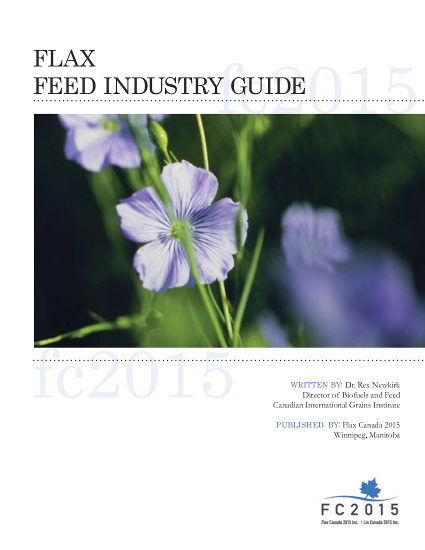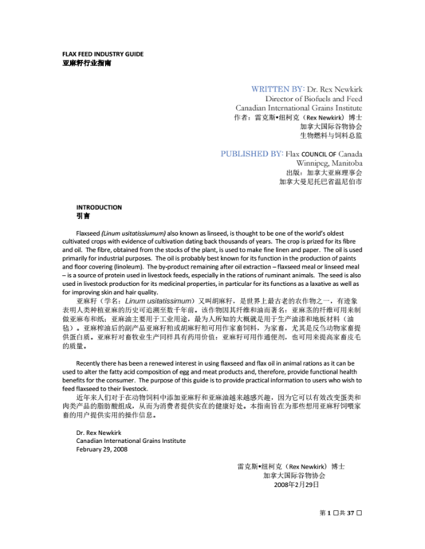Flax in Animal and Poultry Feed for Better Health
Flax is unique in its high alpha-linolenic fatty acid (ALA) content. ALA is an omega-3 fatty acid, which contributes to good animal health. Flax is increasingly used as an ingredient in feeds for better animal health and for enriched food products.
Cattle Rations
Flax in cattle feed can improve the health of animals and boost healthy fats in the products.
For better health
The use of flax (called linseed in the feed industry) is being studied as a way to improve the immune systems in calves. The benefits of omega-3 fatty acids to cattle may be in preventing young animals from developing infections. Similarly, Agriculture and Agri-Food Canada’s multidisciplinary team at the Dairy and Swine Research and Development Centre in Lennoxville, Quebec is studying reproductive and milking performance in animals on flax-enhanced rations. Research has shown flax in dairy cow rations has increased conception rates.
For better foods
Adding flax to cattle feed can also increase the content of healthy fats in meat and dairy products. These products provide consumers with foods that can have a healthier fat profile, and taste good. Such food choices appeal to all health-conscious consumers.
For information on enhancing the fat profile of milk and beef, click on links below:
- Background Information on Key Fats in Milk and Beef – Polyunsaturated fatty acids are those with two or more double bonds in their carbon backbone; they have many vital roles in human health. Dairy and beef producers are interested in increasing the content of two polyunsaturated fats in milk and beef products – namely, alpha-linolenic acid (ALA) and conjugated linoleic acid (CLA) because these fats are important in human nutrition … more
-
Adding Linseed to Feed Enhances the Fat Profile of Milk – The fact that ruminants digest their food in two stages presents challenges for dairy cattle and goat farmers, the main one being that rumen bacteria cannot easily metabolize some fatty acids, particularly polyunsaturated fatty acids like alpha-linolenic acid (ALA), the essential omega-3 fatty acid. Various methods of interfering with the bacterial metabolism of long-chain fatty acids in dairy cattle and goats have been tried… more
-
Adding Linseed to Feed Enhances the Fat Profile of Beef – Several approaches have proven successful in protecting polyunsaturated fatty acids from biohydrogenation in the rumen. These methods have achieved favourable changes in the fatty acid content of beef… more
Equine Feeds
Many horse breeders and owners add milled, cooked or soaked flax seeds, or flax supplements or treats, to equine diets, especially if the horses are not fed on pasture for much of the year. The balance of omega-3 and omega-6 fatty acids in flax is important for horse health. Due to its high alpha-linolenic content, flax can eliminate dull, dry coats in animals, and the itching and scratching that can accompany them. Flax can also prevent colic in horses.
Hog Rations
The Flax Council has been involved in feeding trials in farrowing sows for improved pig production. Notably, flax rations improved sow fertility, allowing sows to be bred more quickly after weaning, and thereby increased the total number of piglets born over a span of three pregnancies. In addition, piglets born to sows on flax were shown to be heavier and healthier, with a lower mortality rate.
Pet Foods
Many pet food manufacturers include milled flax as a source of essential fatty acids in their premium pet foods. The flax balances the omega-3 and omega-6 fatty acid ratio of the food, and promotes healthy skin and coat in pets. The flax also contributes lignans, considered safeguards against tumor formation in pets.
“… consumers continue to treat their pets as well as, or better than, they treat themselves”1.
Poultry Feed
Feeding hens a poultry feed containing flax is an excellent way to enhance the fat profile of the eggs. Eggs with extra omega-3 fats appeal to consumers who want to balance the fats in their diets.
For information on enhancing the fat profile of eggs, click on the links below:
-
The Novel Egg – Opportunities for Flax in Omega-3 Production – Attemptingto fill a niche market as well as strengthen the healthy image of eggs , poultry research has aimed to develop omega-3-enriched eggs as a way of raising the level of omega-3 fatty acids in consumers’ diets. The success of this research has created an exciting opportunity to incorporate and deliver enriched eggs into the rapidly growing functional food market and onto the plates of today’s health-conscious consumers… more
-
Producing Omega-3 Enriched Eggs – In recent years, researchers and egg producers have worked together to improve the omega-3 polyunsaturated fatty acid (PUFA) content of eggs by incorporating omega-3-rich foods like flax seed into the laying hen diet…more
- Philips T. U.S. Pet foods sales go boom.. Rockford, IL: Watt Publishing Co. 2007:9:11. p 23.





